Just one pleasure that you as a nature lover can enjoy is simply strolling through your favourite haunt and seeing what’s there. Like me, you might not recognise every creature encountered but the identification challenge adds a layer of interest and purpose to your ramble. The pleasure of exploration and discovery might prompt further inquiry, more learning, and a greater understanding of the complexity of our wonderful world. In this post, I will show you some of the photos I took on a recent ramble, explain a little about each species, and try to give an impression, however superficial, of how these characters fit together in their world, and ours, and how this can change over time.
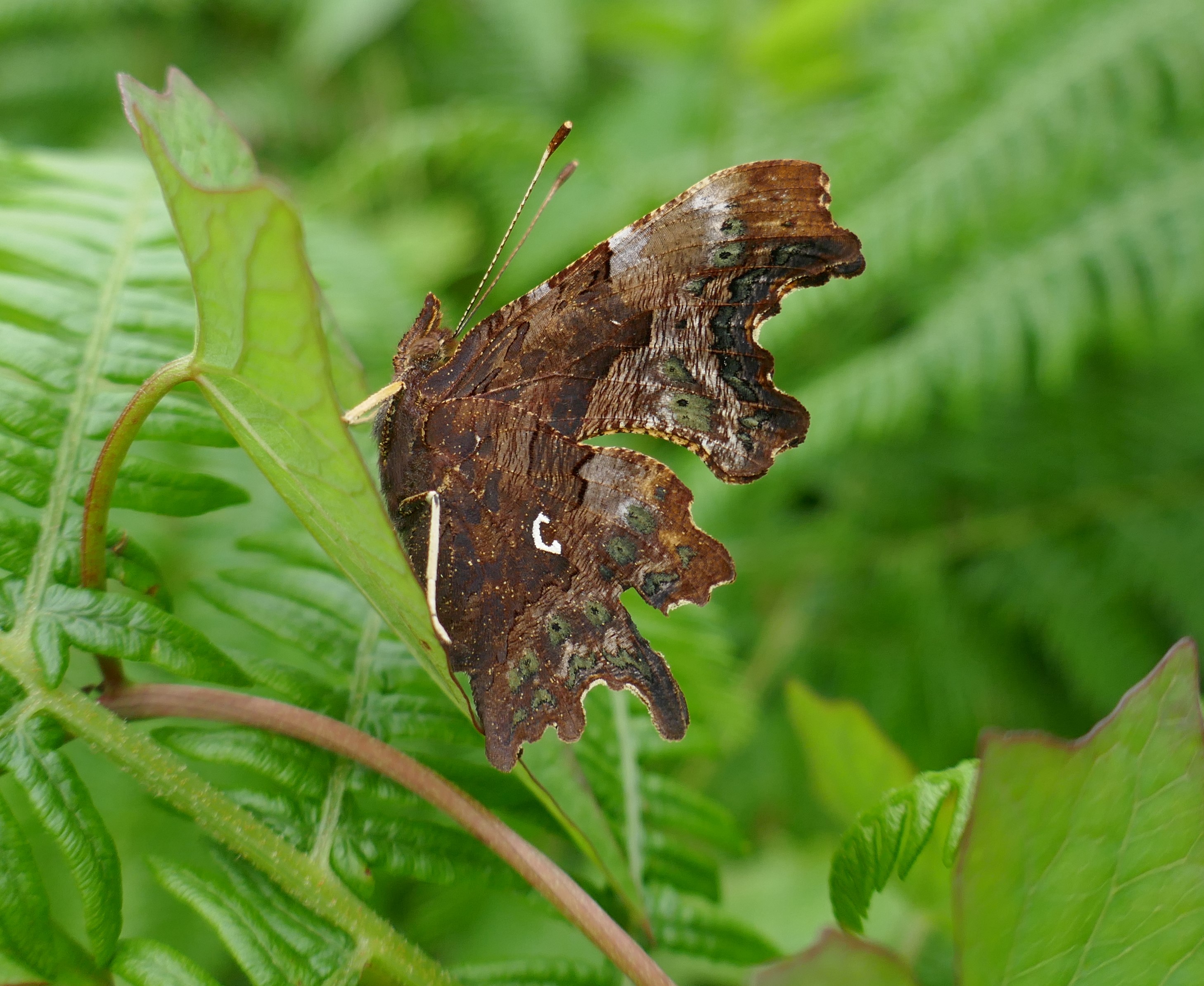
First up is a Comma butterfly. Intriguingly, this butterfly exists in two forms. You can tell something about the life the caterpillar led by looking at the adult. If when the caterpillar when developing, it was feeding on nettles with a high nitrogen content, and receiving 18 or more hours of sunlight, or was developing when daylight hours were increasing, it is likely that a light-form adult would emerge in July/August. This light-coloured Comma breeds soon after emerging. If the day length was marginal, and the larva fed on nutritious leaves in warm conditions, a light Comma is also likelier.
A dark Comma results when the caterpillar fed when the day length was declining, or it was cool and the plant was not especially nutritious. The dark Comma will rarely breed until the following spring. It behaves like the Peacock butterfly that hatches in summer, feeds, and enters hibernation in cool, dark, dry situations in woodland. A much darker underside makes it far harder for birds to find than light-coloured Commas.
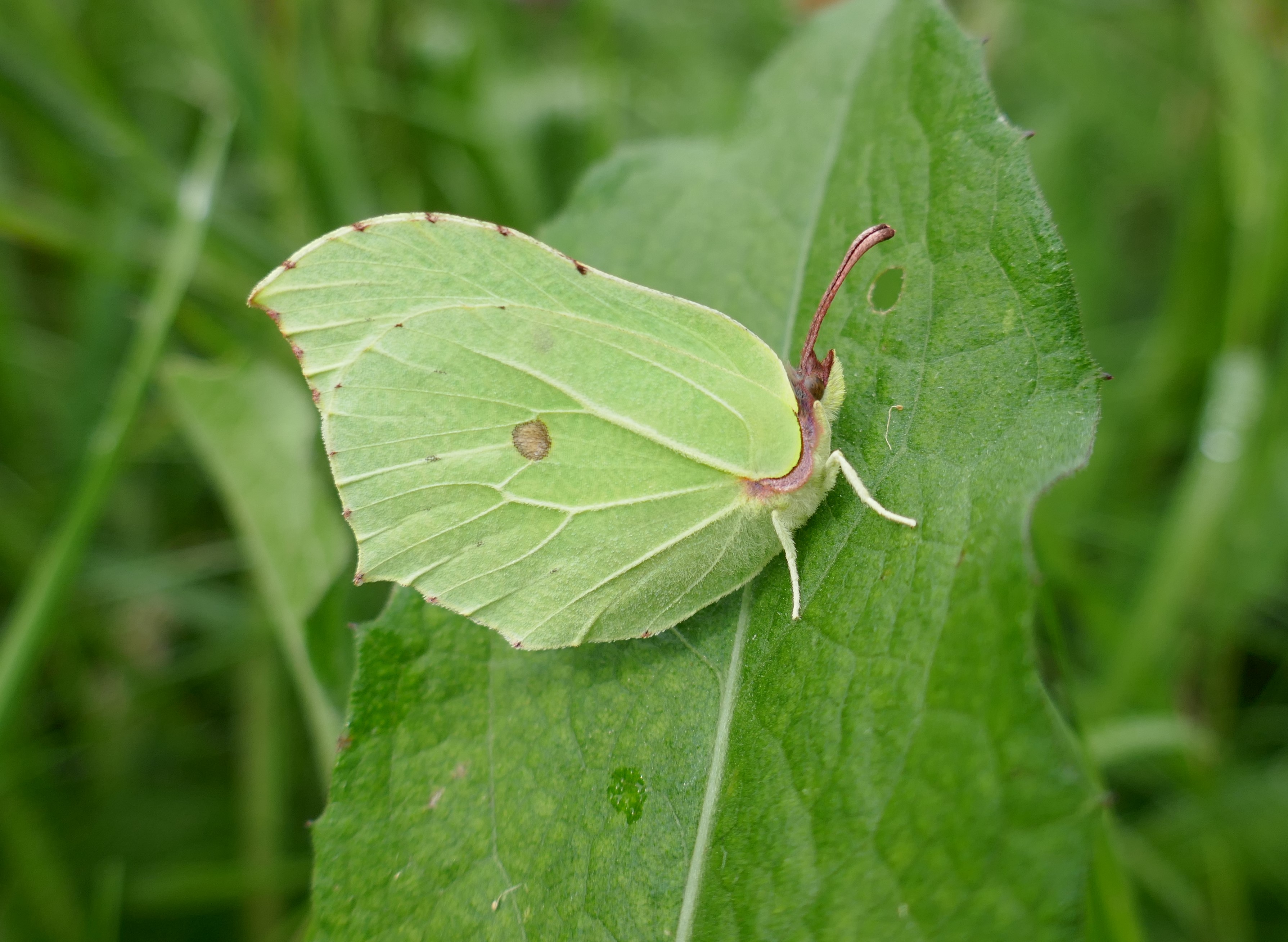
Then I sighted a female Brimstone, resting. Like the Peacocks, which were found nearby, it was not very active and was not looking to fly into the path of a male. Neither of these two will mate until next year. Both pass the winter as adult butterflies. The brimstone among leaves that match its outline and vein markings, the Peacock in dark places that match its black underside.
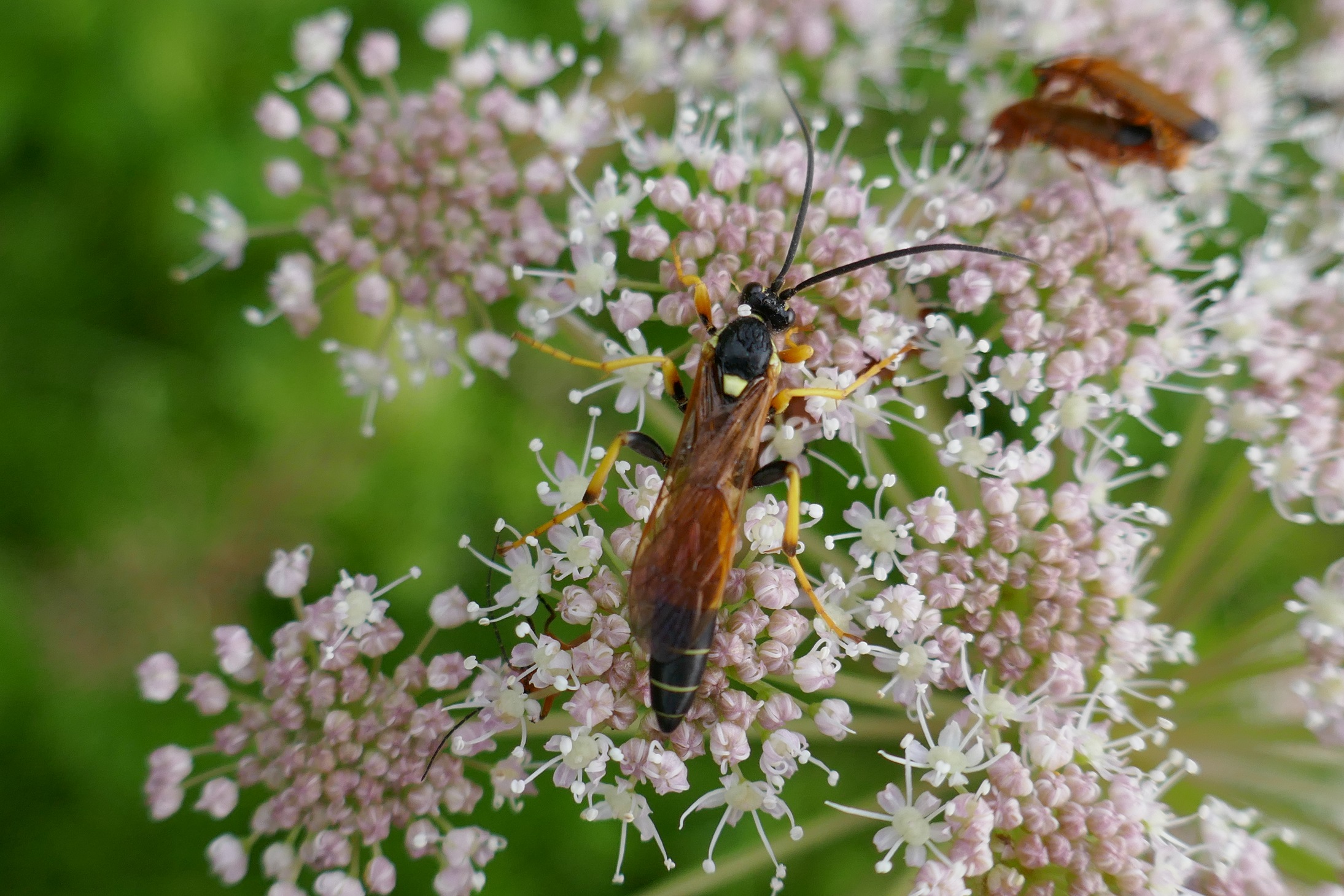
A large wasp-like creature busily foraging on a Wild Angelica flower caught my eye next. This is an ichneumon wasp, one of many similar-looking wasp species. These wasps make a living from moth caterpillars and other insect groups and arachnids (spiders) by parasitising them. The noctuid moth family is often used as hosts for these wasps, which inject eggs into the caterpillars, or lay near them, develop inside the caterpillar before emerging from the dead or dying caterpillar and pupating. Ghoulish though it sounds, the wasps regulate population sizes and, indirectly, vegetation growth, preventing mass population booms that threaten to self-annihilate by eating all their food.
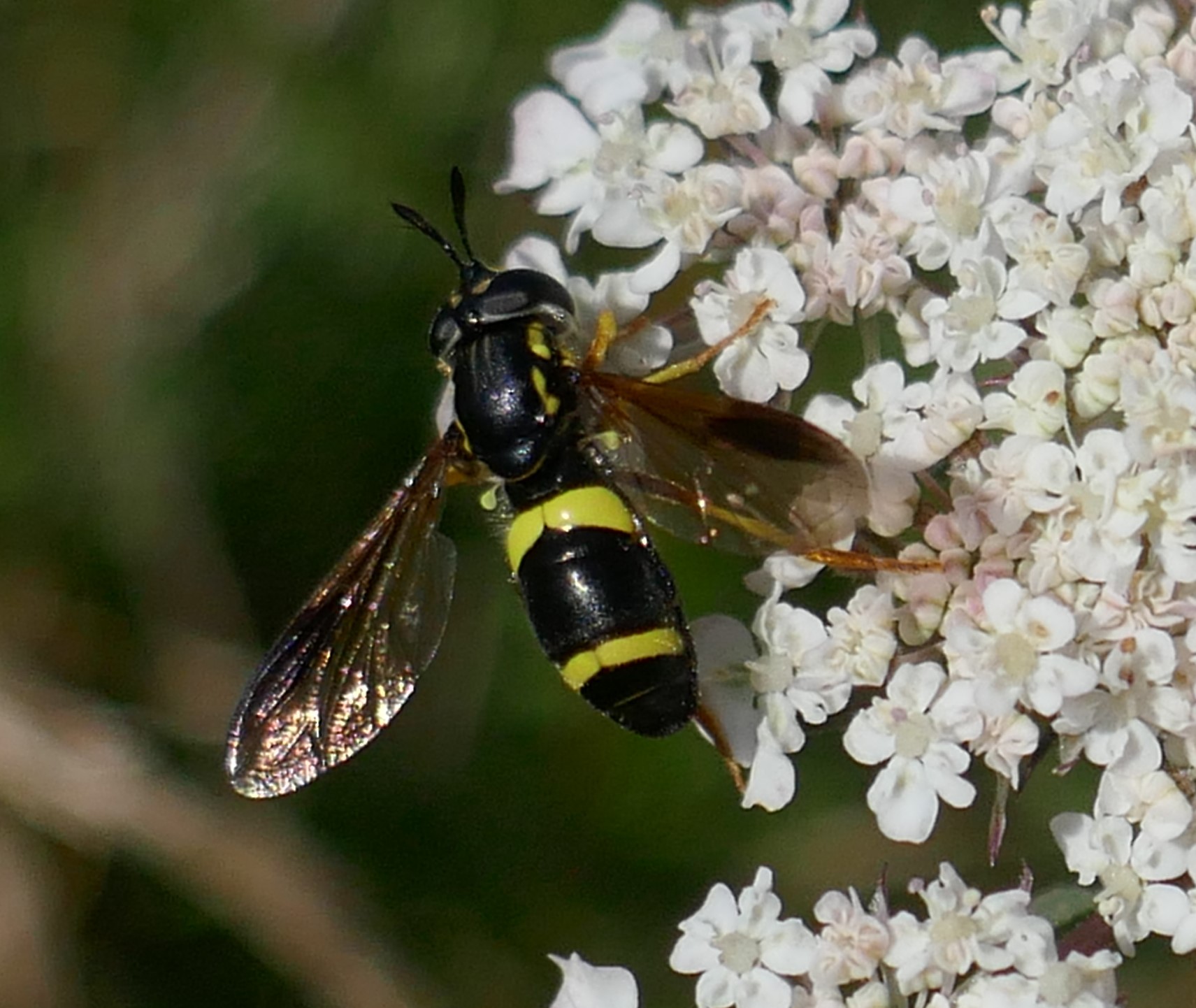
Another wasp-like creature was on the Wild Angelica, but this one is not a wasp, but a fly. The Two-banded Wasp Hoverfly is well-named. A nectar-feeder as an adult, the larva feeds on aphids. It is quite a striking-looking creature but is usually seen singly.
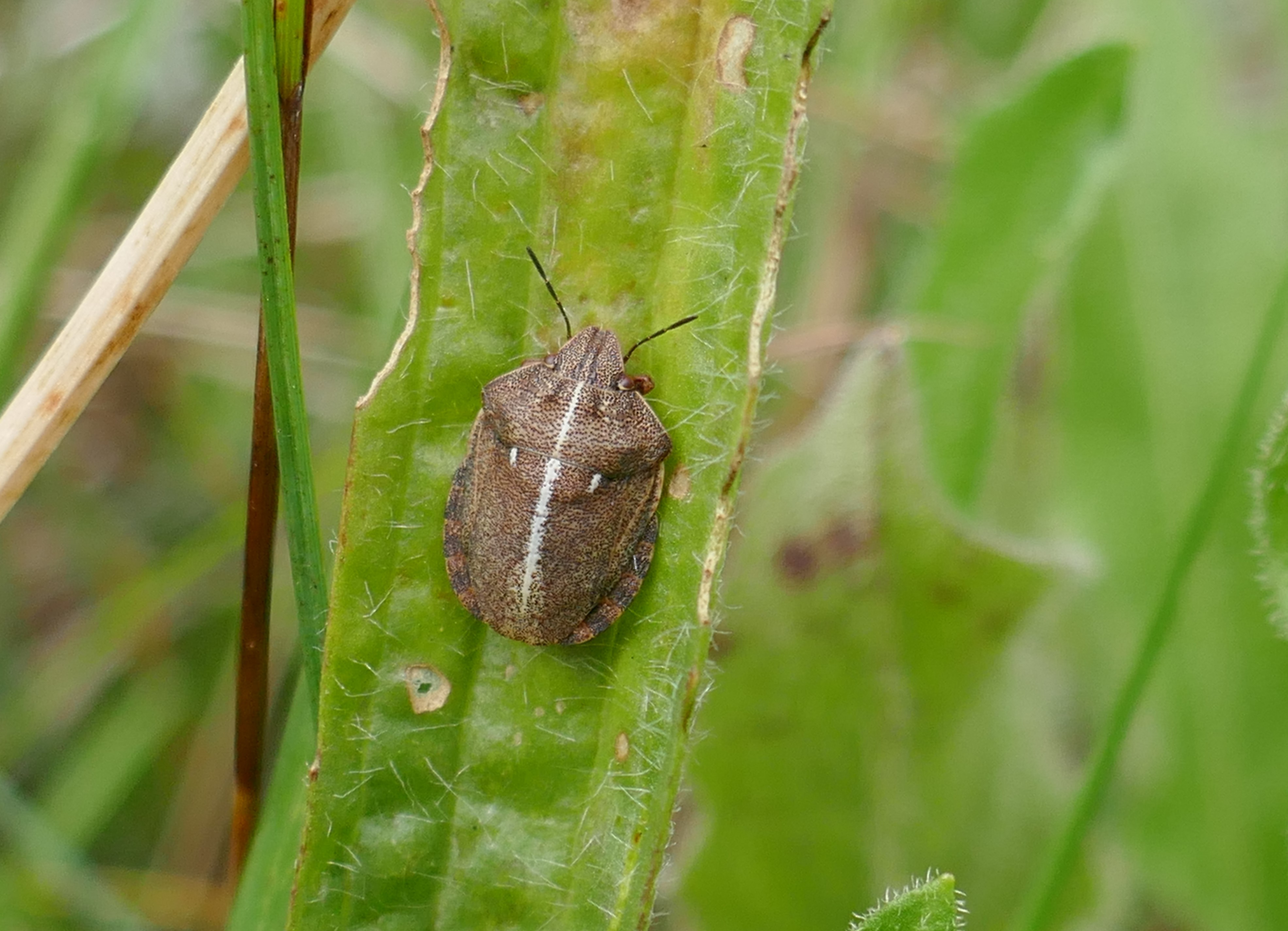
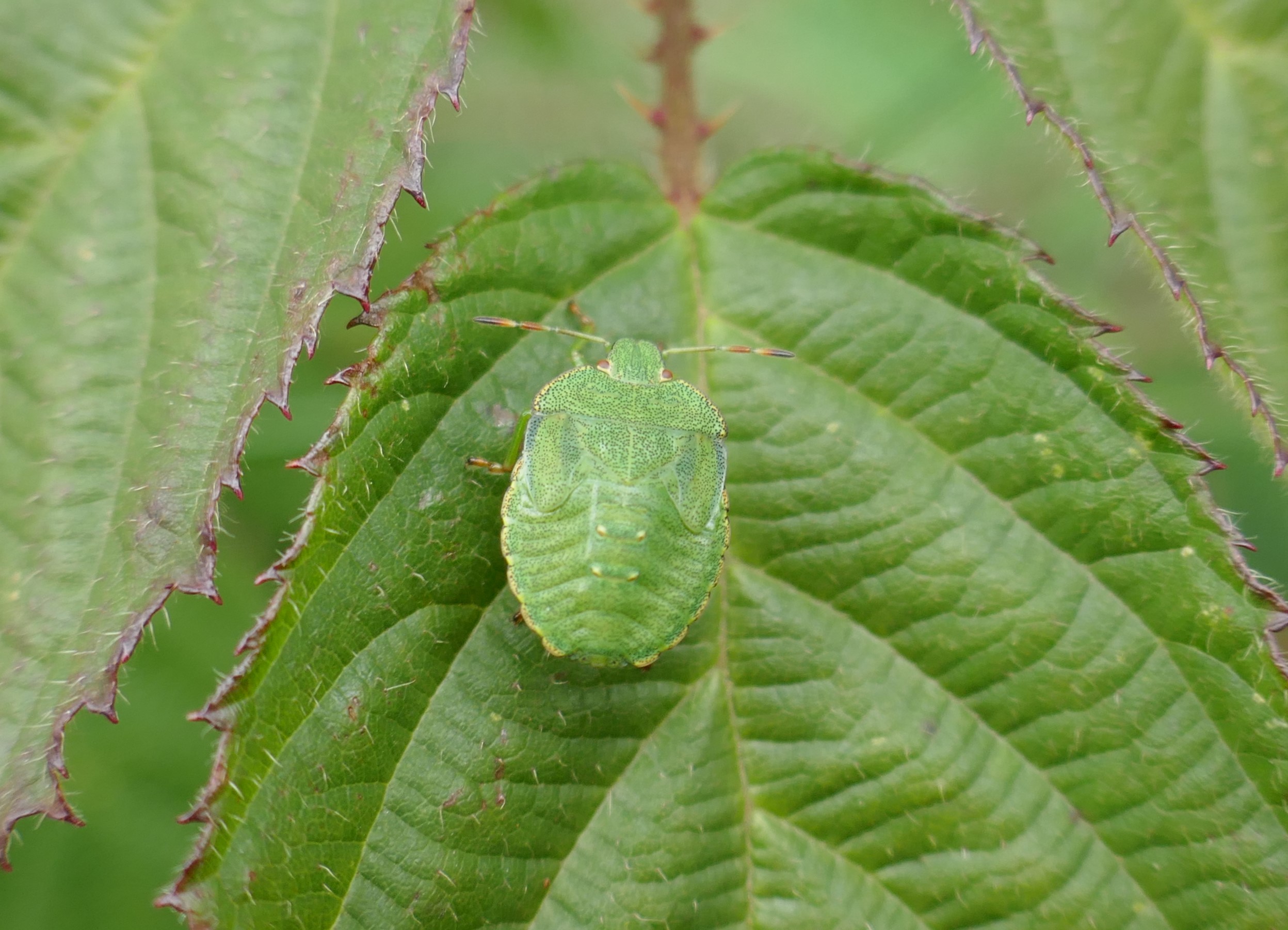
A much quieter creature next took my eye. This was a Tortoise Shield Bug, a plant feeder. Another one was on bramble, the Green Shield Bug, another plant eater. If disturbed it often emits a marzipan smell, which is quite cloying, but harmless. If cutting your meadow back in late summer or autumn you might notice it! It spends the winter as an adult and breeds the following spring.
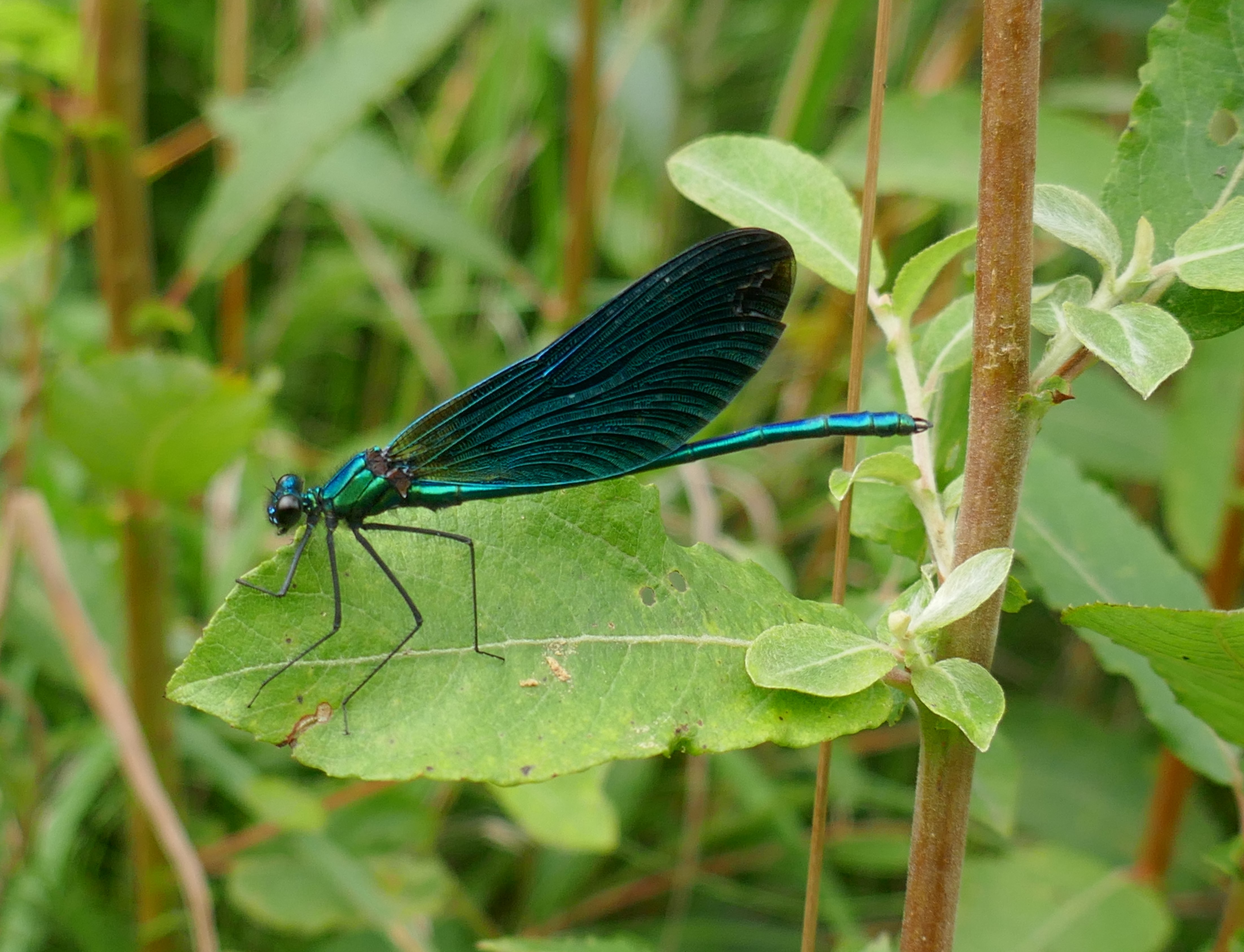
The pondside scrub vegetation yielded two male Beautiful Demoiselles, which were displaying, hoping to catch a girl’s eye. They were skittish, landing only briefly so I was delighted to get a photograph. It needs fast-flowing, clean, pebble-or sandy-bottomed streams. The pond is fed by a clean stream, with a marl bottom, which obviously keeps it happy.
The skittishness of males might be related to their need to protect an egg-laying site from other males. His female must lay her eggs there under his protective gaze. If not, an interloper might mate with ‘his’ female and replace his sperm. It is a tough life being a male Beautiful Demoiselle!
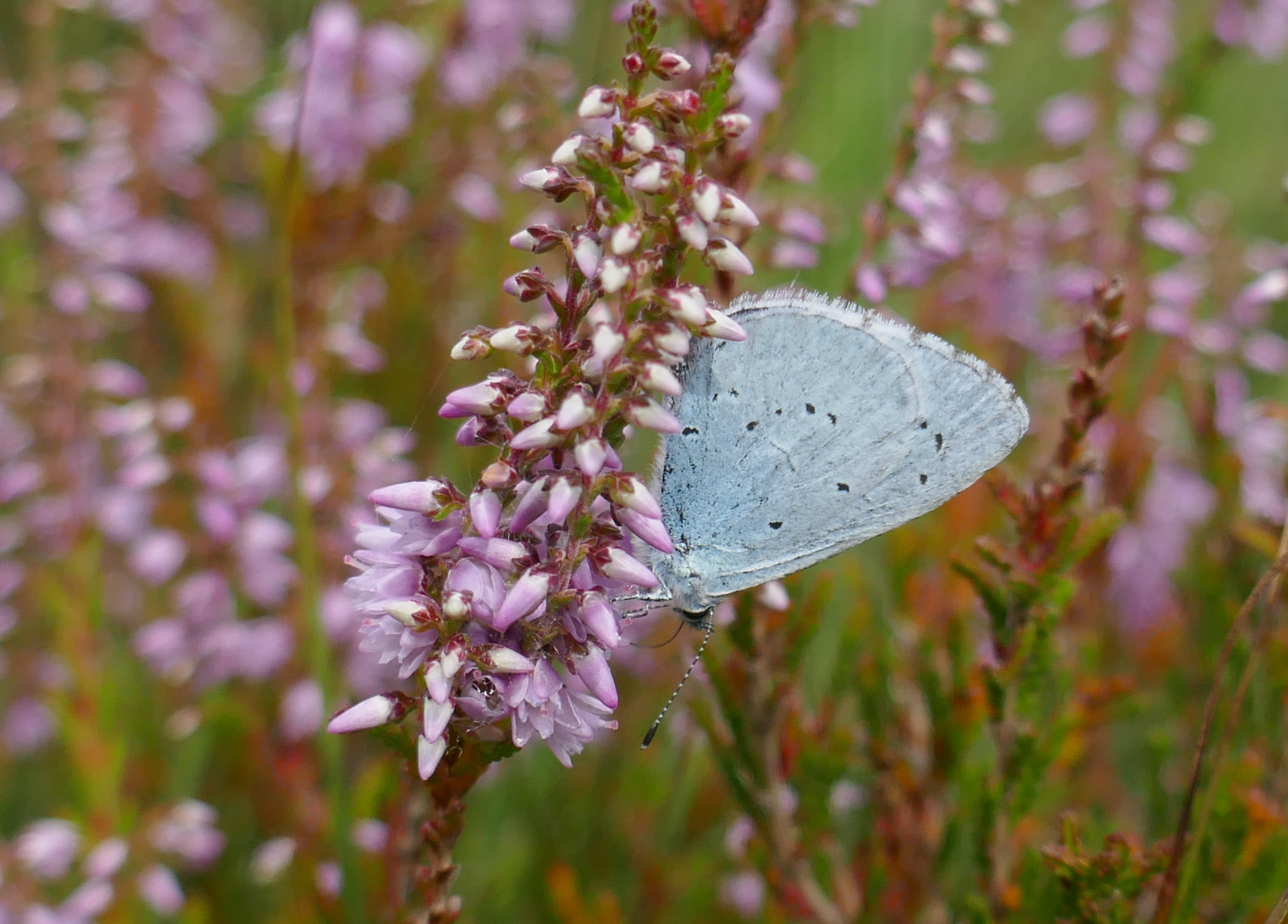
A sighting that surprised me was a male Holly Blue. It is a less frequent butterfly in rural locations, preferring suburban and urban gardens where there are heat traps, and masses of holly and ivy for breeding. The butterfly uses many other plants for breeding, but these are the main choices, in spring and summer/autumn respectively. The one I saw was feeding on Common Heather, slate blue among pink evoking delicate beauty.
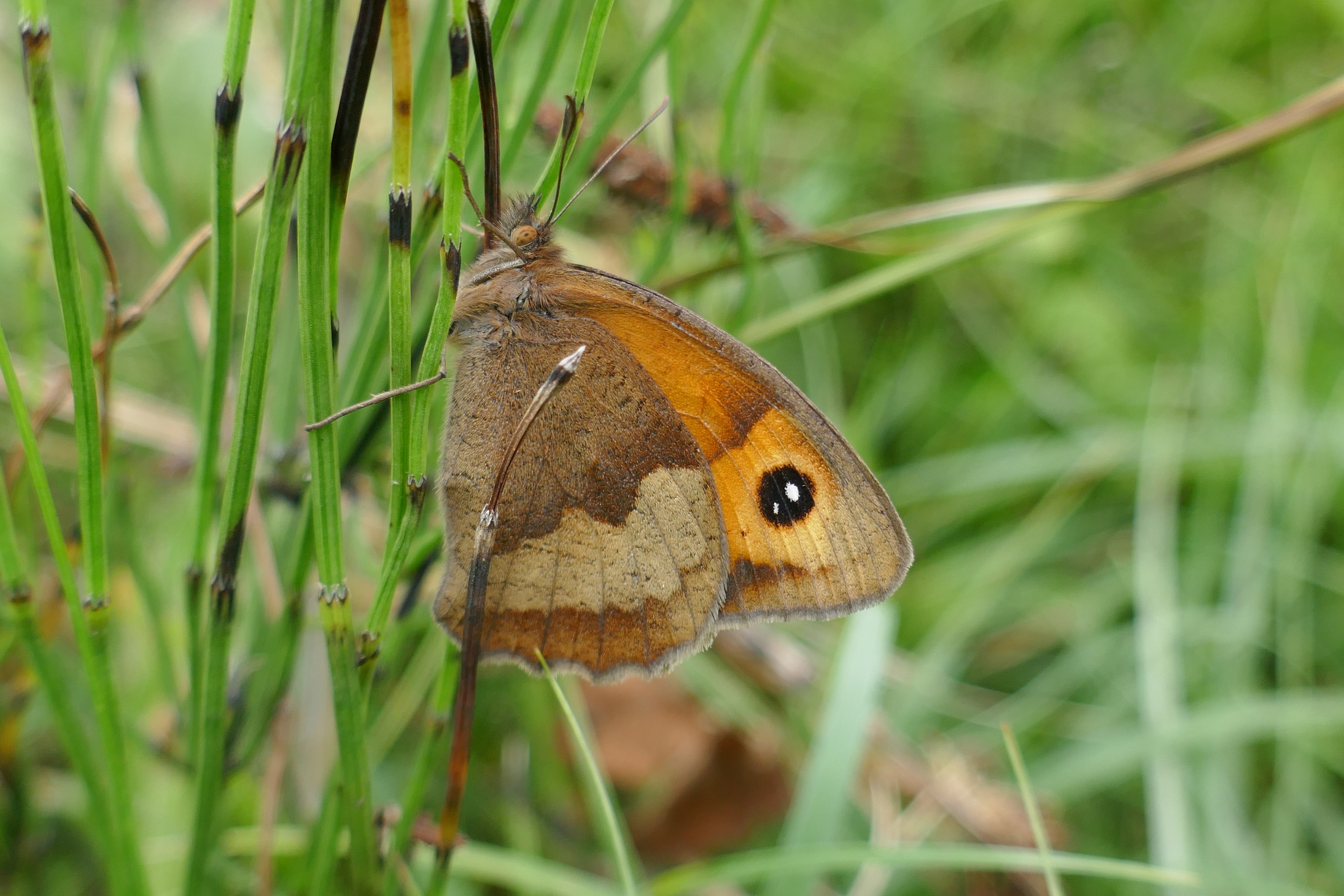
Another surprise is the number of very fresh Meadow Browns. This species emergence times are quite uneven across the country, even with an individual county. Thus, 29 Kilometres away on the Kildare/Meath border, the Meadow Brown is now scarce, with a few faded, geriatric specimens flapping weakly in sheltered places. In Lullybeg it remains abundant, with several newly hatched individuals like the one pictured seen on my early August ramble.
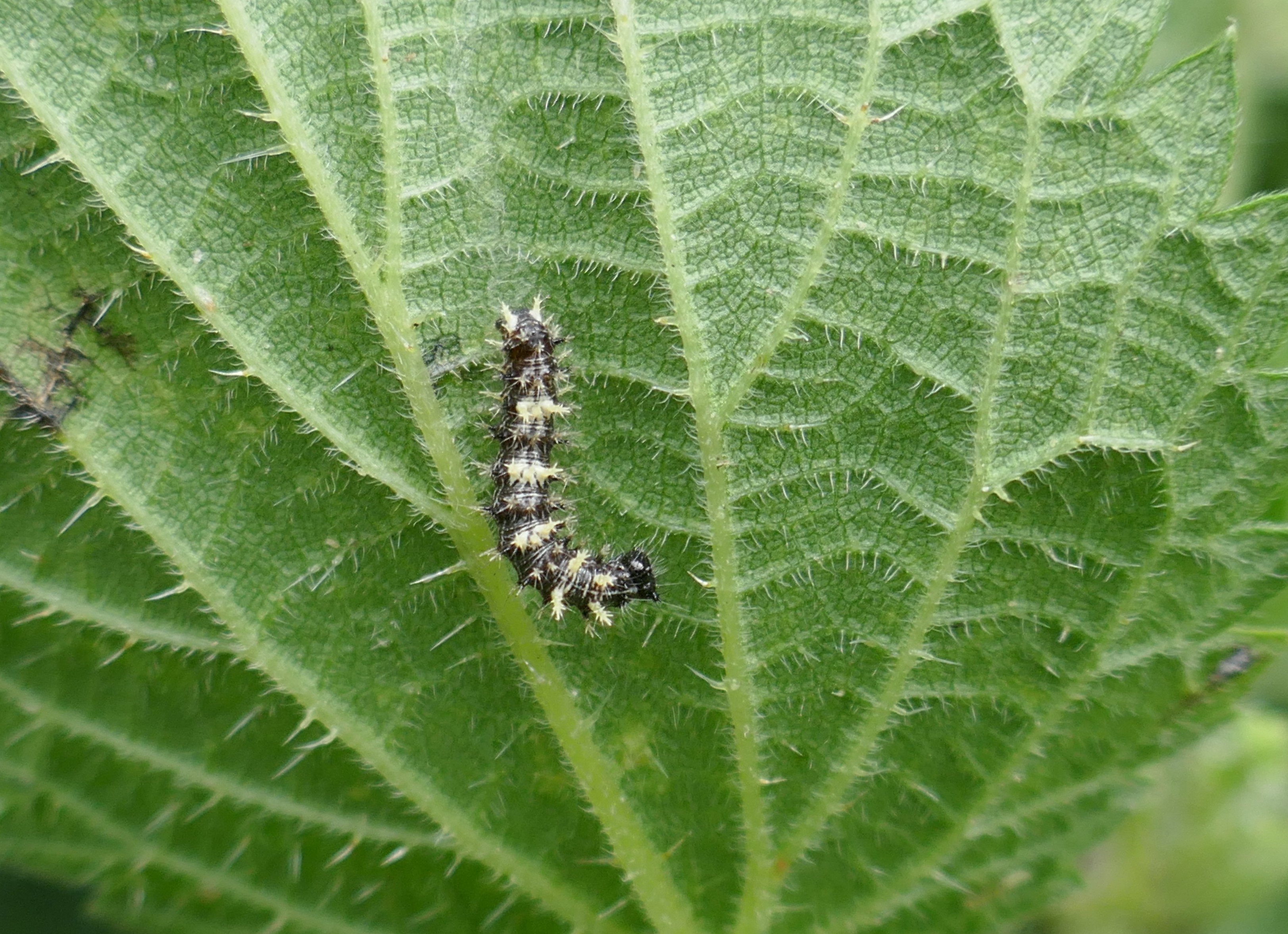
When I arrived home, I checked some roadside Stinging Nettles. Under a large leaf about halfway down the stem of a nettle was a Comma caterpillar, in its second instar. This caterpillar is developing under rapidly declining daylight, meaning that it is guaranteed to be a dark Comma. This will, should it survive, be flying in September, and will join its uncle, pictured at the start of this article, in hibernation. Therefore, our spring Comma population, all (or nearly all?) dark form Comma butterflies, consists of two generations from the previous year, ones that hatched from their pupae in July/August and the second brood adults hatching in September/October.
The ramble showed how interactions are taking place between different aspects of the biodiversity encountered. The wasp, hoverfly and butterflies fed from flowers, pollinating them to produce seeds for plant reproduction and seed-eating animals. The butterfly larvae eat plants and are in turn eaten by parasites and other predators, which themselves are used in the food web. Species regulate and are regulated by other members of their community. This creates a balance, so no member of the community dominates at the expense of others, over time.
There are deeper interactions than can be described here, but one interesting study that might indicate the effects of climate warming on some of our butterflies and their community has been conducted in Sweden. The Swedish study looked at four nettle-feeding butterflies and at how climate change has influenced their populations, in the context of the arrival of the nettle-feeding Map Butterfly, which is tracking climate change by extending its European range northward, just like the nettle-feeding Comma.
The study, Rewiring of interactions in a changing environment: nettle-feeding butterflies and their parasitoids (citation below) looked at the interactions between four nettle-feeding butterflies and their shared parasitoids in Sweden and the impact of the newly arrived Map butterfly, via its parasitoids, on three long-term residents, the Small Tortoiseshell, Peacock and Red Admiral (the Red Admiral is described by the study as a resident, but it is a migrant to Sweden, breeding there annually).
They collected 6777 wild larvae of the four species over two years. Of the 6777 collected larvae, 1508 were parasitised (22%) and produced parasitoids from three families: Tachinidae (Diptera), Ichneumonidae (Hymenoptera) and Braconidae (Hymenoptera). They identified 11 species: the tachinids (flies) Pelatachina tibialis, Sturmia bella, Phryxe vulgaris, Phryxe nemea, Pales pavida and Blondelia nigripes, the ichneumonids (wasps) Phobocampe confusa, Thyrateles haereticus and Thyrateles camelinus, and the braconids (wasps) Microgaster subcompleta and Cotesia vanessae. Some of these parasitoids have not been recorded here; those that occur in Ireland are in bold. Overall, 76.7% of the parasitised larvae were parasitised by either Pelatachina tibialis (34.6%), Phobocampe confusa (28.5%) or Sturmia bella (13.6%). All four butterflies were attacked by these three parasitoids, except for the Map butterfly which was not infected by P. confusa. The Red Admiral was attacked by most parasitoid species, including representatives of all three families. Unknown causes were also responsible for caterpillar mortality.
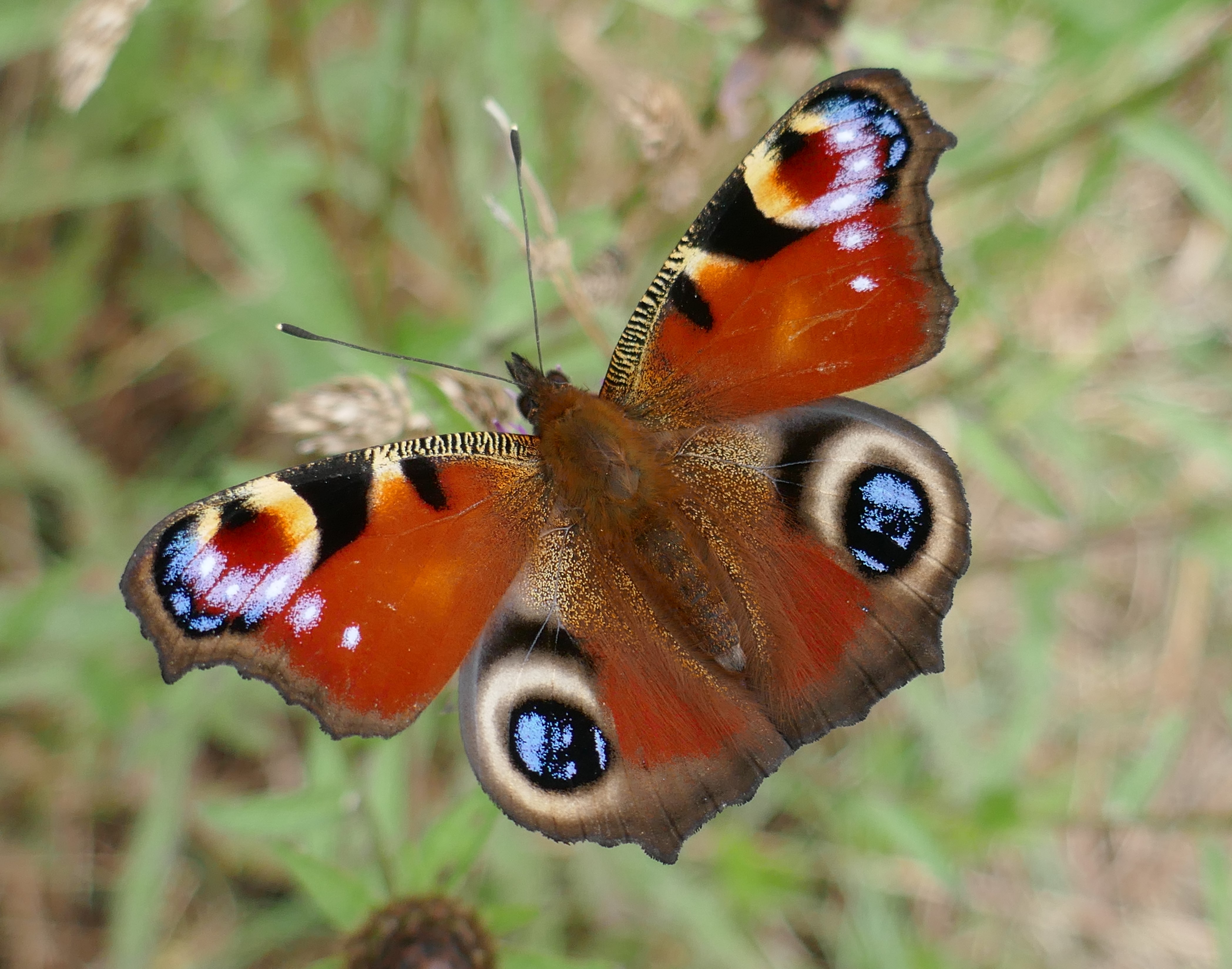
The most heavily parasitised butterfly was the Small Tortoiseshell, followed by the Peacock. The Red Admiral was third and the Map butterfly was least impacted. Parasitism rate increased in the Peacock when its larvae were found with the larvae of the Map butterfly and Red Admiral but decreased when it co-occurred with the Small Tortoiseshell. For its part, parasitism increased in the Small Tortoiseshell when its larvae occurred with those of the Peacock. They also observed that the parasitism rate in the Peacock increased with the number of co-occurring butterfly species. Looking at parasites that infect both the Map and the native butterflies (Peacock, Small Tortoiseshell and Red Admiral) they found that Small Tortoiseshell had higher levels of infection when it co-occurred with the Map.
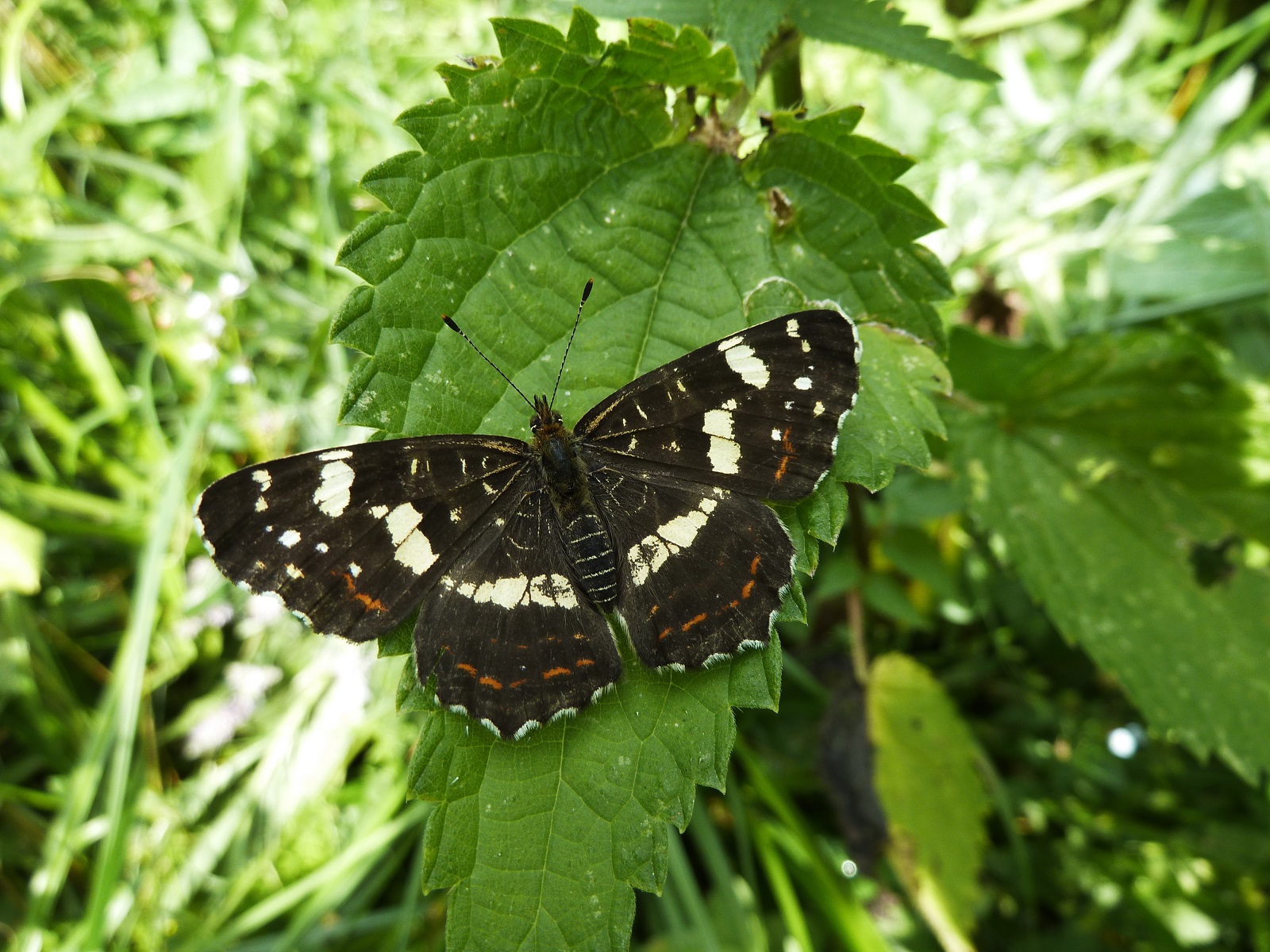
It was also discovered that in the Swedish sites where the Map was known for the longest, the Small Tortoiseshell and Peacock had higher rates of parasitism. The low rates of parasitism in the Map and Red Admiral are discussed but no definite conclusion is made. However, one strong possibility for the low infection rate in the Map is that because the Map is a recent colonist in Sweden, it may have escaped its parasitoids initially, and is only beginning to recruit parasitoids in the last c.10 years. In areas where the Map had only recently arrived, infection rates were lower for the Small Tortoiseshell and Peacock.
The Map might be causing higher infection rates by shared parasitoids by providing a host for the parasitoids when the larvae of the Small Tortoiseshell and Peacock are scarce. The three species’ caterpillars overlap in their occurrence, but there are phenological differences (differences in the timing of the appearance of the caterpillars).
Populations of the Small Tortoiseshell are bivoltine (two generations) in Sweden. Its larvae are recorded from early May to the end of August with the first generation being found from early May and the second generation from late June. The Peacock is univoltine (one generation) in Sweden with larvae observed from late May to early August (like in Ireland). The Map is a bivoltine species but in contrast to the Peacock and Small Tortoiseshell, which overwinter as adults, the Map hibernates in the pupal stage. Larvae from the first generation are found in the field in June; larvae from the second generation are found from the end of July to early September. The Red Admiral is a migratory butterfly in Sweden and its population depends on the migratory influx from the areas where the species is resident. It is univoltine in Sweden with larvae observed in the field from May to early September.
All species are distributed across Sweden, except for the Map which is currently limited to the southern half of the country.
Therefore, there are times in the year when Map larvae are plentiful but those of the Peacock and Small Tortoiseshell are less numerous. Phenological differences in the parasitoids between hosts might also mean the Map is assisting increased infection rates in its butterfly relatives. If correct, the Map is reducing the competition for its food (nettles) during its establishment phase, but if the Map recruits more parasitoids, as the study indicates is likely, a balance between the four butterflies might be struck.
However, the Swedish study did not look at several other potentially relevant factors, including the parasitoids that the Map may have introduced to the other three butterflies, only looking at shared parasitoids, and looked at larval parasitoids, not egg or pupal ones. Thus, a warming climate that causes a butterfly to extend its range may bring challenges for established natives. We simply do not know the extent of these. The study does not point out that all four of the nettle-feeding butterflies occur further south in Europe.
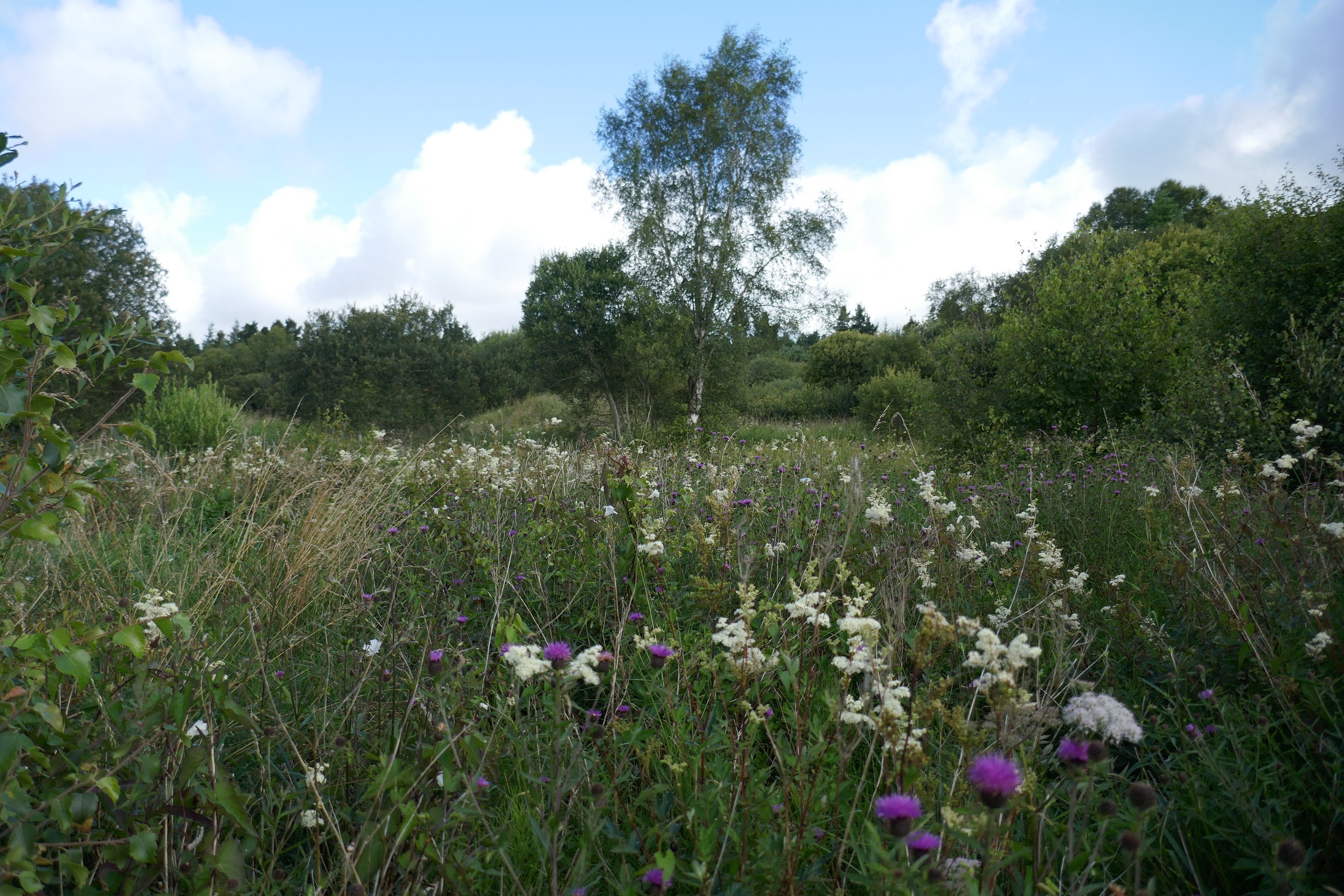
While I love the Comma butterfly and rejoice in its colonising zeal, are our established natives being put under increased survival pressure? In Ireland, the Comma has been found breeding mainly on the Stinging Nettle. The recent decline in the Peacock population in northwest Kildare coincides with the establishment of the Comma in the area, but this abundance decline might be coincidental and related to many other factors, such as weather conditions, changes in the habitat, unshared parasitoids, changes in the behaviour and population of the parasitoids, viruses, and bacterial infections unrelated to the Comma’s arrival.
None of this is known. But it certainly adds intrigue.
Our Small Tortoiseshell, Peacock, and Red Admiral populations are very important in our landscape because they are common, widespread, and often abundant. The impact on the wider community is all the greater if they decline because these abundant animals connect with a large range of species.
That happy, carefree ramble reminds us that we have so much to learn. Keep watching our butterflies, our canary in the coal mine.
Key Reference
Audusseau, H., Ryrholm, N., Stefanescu, C., Tharel, S., Jansson, C., Champeaux, L., Shaw, M.R., Raper, C., Lewis, O.T., Janz, N. & Schmucki, R. 2021, “Rewiring of interactions in a changing environment: nettle‐feeding butterflies and their parasitoids”, Oikos, vol. 130, no. 4, pp. 624-636.

